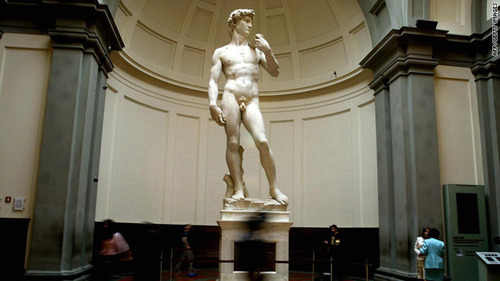
via cnn.com
The city of Florence and the national government of Italy are in a dispute over which of the two owns Michelangelo Buonarroti’s famous statue of David. The dispute is more than about just pride of ownership; it’s also about who should be getting how much of the annual $10 million in admission ticket sales from visitors paying to see the statue.
The claim by Florence has been put forth for many years, but more recently a request was made by Florence to the Italian government to hand over the earnings, on the basis of Florence’s right of ownership. Following the request, the Italian Heritage Ministry commissioned a study to determine the rightful owner.
Looking through centuries of archival material, two lawyers commissioned by the national government produced a nine-page document that concluded that David belongs to Italy. The major legal point they made was that between the time of Republic of Florence, which existed at the time David was created, until the unification of Italy in 1870, the city was part of a number of successor states and they did not provide a clear continuity in ownership. More importantly, the unified Italy was the final successor state of all the Italian states and so the inheritor of all the states’ assets.
The city’s argument is that there is a legal document that Italy was a party to from 1871 that decreed that the Palazzao Vecchio (the town hall outside of which David was located at the time) and everything in it was given to the city of Florence. The counter argument from the national givernment’s lawyers is that the document did not explicitly mention David, “even though by this time it had acquired an enormous symbolic value”. In addition, when David was moved to La Galleria dell’Accademia in Florence in 1873 (to bring it inside for conservation purposes), the city did not assert any rights to the sculpture. In fact, a year later, the mayor of Florence at the time claimed David belonged to the Italian government and for that reason billed Rome for its moving cost.
The Italian Heritage Minister stated that he hoped an amicable agreement could be worked out between Italy and Florence to avoid any further controversy.
The money for the admission to the state run L’Accademia gallery in Florence goes to the Italian government, and not the city. The gallery has 1.5 million visitors a year and Florence has to pay for cleaning and security in the area. The mayor doesn’t feel that it is fair that the burden of maintaining the city and its centuries-old buildings should be paid by its citizens without them being able to share in the profit its key attractions provide.
The ruling on David is considered even more dangerous because Florence also claims ownership of many pieces of art in other local state-run museums such as the Uffizi Gallery.
Michelangelo was commissioned in 1501 to create the sculpture for the city’s cathedral. However, when it was finished in 1504, it was placed in the Piazza Della Signoria at the entrance to the Palazzo Vecchio. It was considered a masterpiece from the beginning, even though David has a major flaw: an uncircumcised penis on one of the most famous Hebrews of all time.
A replica was placed in the Piazza della Signoria in 1910, which remains on view for the public for free.
No comments:
Post a Comment